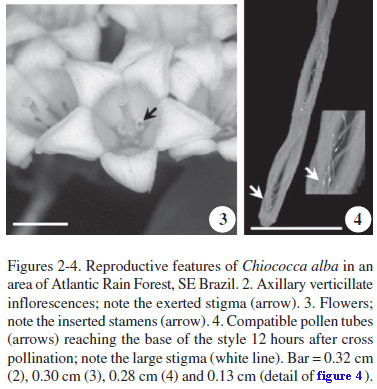The family Rubiaceae comprises a wide spectrum of floral mechanisms and two of them seem to be common in certain groups, e.g., distyly in Rubioidae and styllar pollen in Ixoroidae. These mechanisms include herkogamy, which is interpreted as a strategy that avoids self-pollination. This is the first report on the reproductive biology of Chiococca alba, a species that is widely distributed in America. We studied floral biology and the mating system, which were evaluated through fruit set comparisons after controlled crosses (self- and cross-pollinations and test for apomixis), as well as through the evaluation of pollen tube growth resulting from these controlled crosses. Flowers of C. alba are herkogamous, cream, protandrous and lasted for two days. No measurable nectar was found, despite the presence of a nectary-like structure at the base of the corolla tube. Chiococca alba is a preferentially self-incompatible species, but self-pollination and apomixis also contribute to the natural fruit-set. Its reproductive strategy (herkogamy associated with protandry) is different from that expected for members of Chiococceae tribe (i.e., styllar pollen presentation).
Atlantic Rain Forest; breeding system; Chiococca; floral biology; herkogamy; pollination; Rubiaceae




